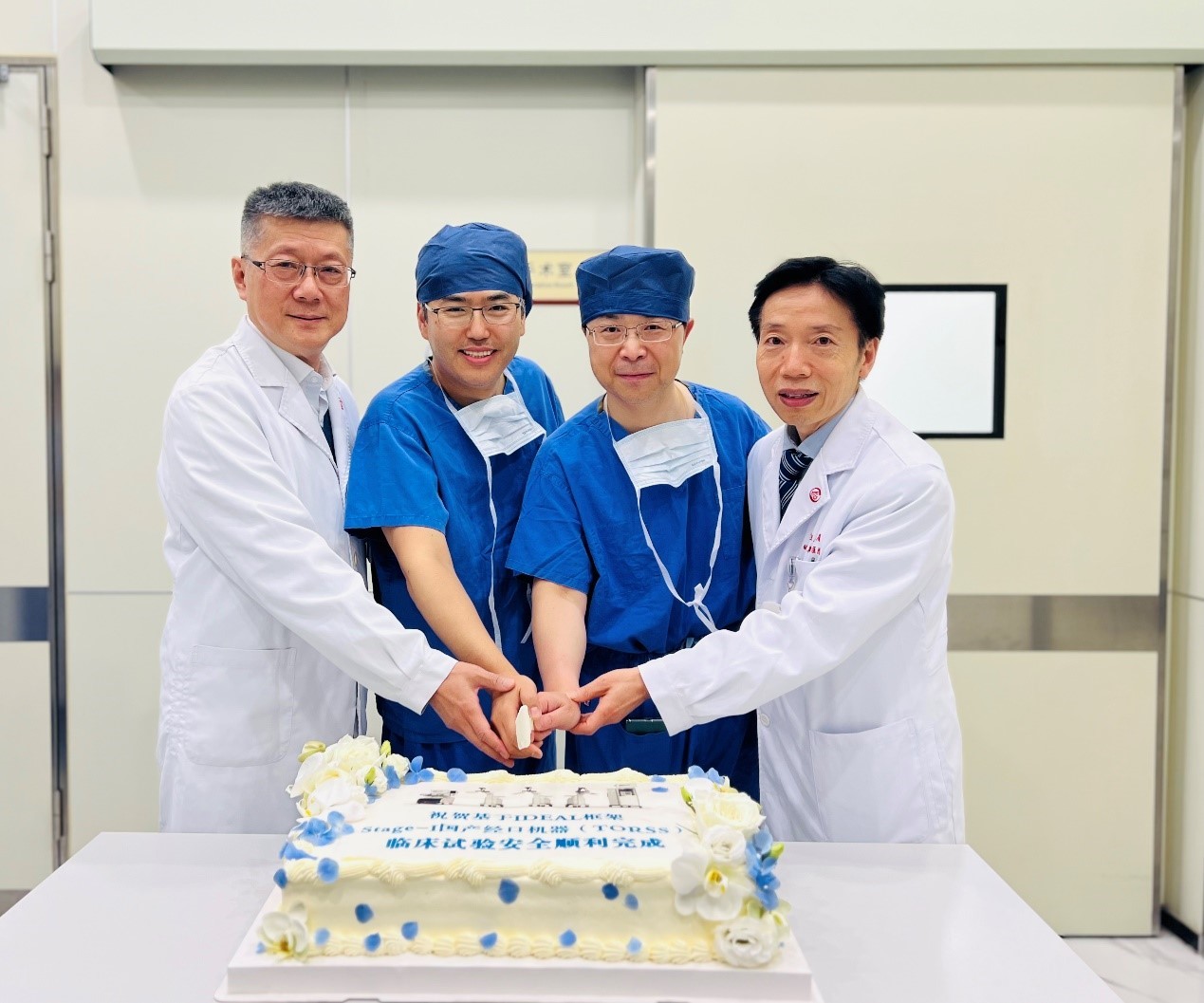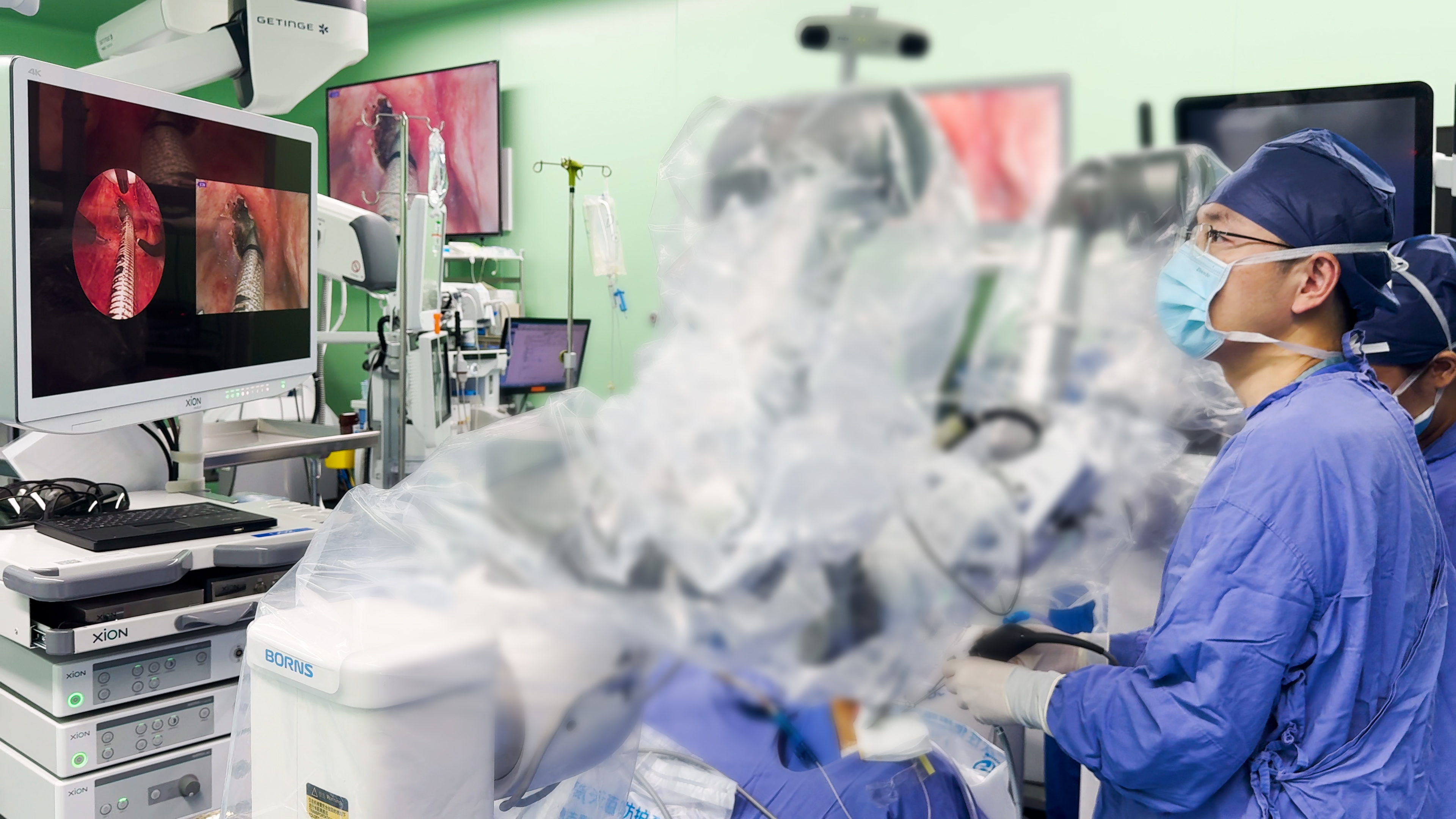The New Flexible Pharyngeal-laryngeal Surgical Robotic System TORSS® Successfully Performs the World's First Glottic Area Tumor Surgery!
Release time: Oct 29,2024
BORNS Medical Robotics, in collaboration with Fudan University’s Eye, Ear, Nose, and Throat (ENT) Hospital, has achieved a historic milestone in medical robotics. On the morning of October 29, 2024, the new flexible pharyngeal-laryngeal surgical robotic system TORSS® successfully completed the world’s first glottic Area Tumor Surgery. This groundbreaking surgery represents a significant leap forward in AI-powered medical robotics, offering a revolutionary method for the minimally invasive treatment of head and neck tumors.

1. Professor Liang Zhou, Chair of ENT Department, Shanghai Medical College of Fudan University.
2. Dr. Yao Li, Founder of Borns Medical, Adjunct Professor of Eye & ENT Hospital of Fudan University
3. Professor Lei Tao, Director of Head and Neck Surgery, Eye & ENT Hospital of Fudan University
4. Professor Xintao Zhou, Director of Eye & ENT Hospital of Fudan University
Tackling the Challenges of Minimally Invasive Surgery
Head and neck surgery is among the most complex and high-stakes specialties due to the dense nerves, blood vessels, and vital organs such as the trachea, esophagus, and vocal cords. The precision required leaves no room for error, as even minor deviations can lead to irreversible damage affecting speech, breathing, or swallowing functions.
Traditional surgical methods often cause significant harm, diminishing patients' quality of life. Existing minimally invasive techniques for treating pharyngeal and laryngeal tumors, such as laser or plasma technology under a microscope or endoscope, face limitations including restricted visibility, bleeding control challenges, and steep learning curves.
On October 29, the TORSS® system successfully addressed these challenges by performing its first clinical application—a glottic tumor resection on a 53-year-old patient. One year ago, he underwent partial laryngectomy and neck dissection for laryngeal cancer. One year prior, the laryngeal cancer patient had partial laryngectomy, neck dissection followed by postoperative adjuvant radiotherapy due to the identification of high-risk pathological factors. During postoperative follow-up, recurrent new lesions were detected in the vocal cord area.
The surgery was exceptionally minimally invasive, with blood loss of less than 1 milliliter. The patient experienced a swift recovery and resumed normal activities the following day. This achievement represents a paradigm shift in head and neck surgery, providing precise tumor resection while preserving critical functions.

Medical Robotics Breakthrough
The development of flexible robotic systems for minimally invasive head and neck surgery has long been a challenge for both engineering and clinical medicine. TORSS® sets a new standard with precision surgical instruments that navigate the intricate anatomy of the oral cavity and throat.
Its advanced visualization system provides high-resolution imaging with enhanced depth perception and panoramic views, enabling precise operations in the narrow spaces of the oropharynx, larynx, and hypopharynx. These capabilities allow surgeons to perform complex procedures with unparalleled accuracy while minimizing trauma.

A Revolutionary Clinical Approach
The TORSS® system avoids the destructive resections common in traditional surgeries. Its design ensures stability and flexibility, reducing tissue trauma in critical areas such as the maxillofacial, oropharyngeal, and hypopharyngeal regions. By overcoming spatial and precision limitations, TORSS® makes truly non-invasive robotic surgery a reality.
This clinical success provides patients with safer, more effective, and personalized treatment options. The TORSS® system’s innovative approach revolutionizes healthcare, enabling early detection and intervention for head and neck tumors. It represents a leap forward in safeguarding global health and delivering life-changing benefits to patients worldwide.
Innovation in Translational Medicine
The successful clinical application of the TORSS® robot underscores the power of interdisciplinary collaboration in advancing translational medicine. BORNS Medical Robotics is committed to extending the impact of this breakthrough. Future initiatives will include global clinical research, education, and health economics studies focused on the TORSS® system across the United States, China, India, and the European Union.
With TORSS®, BORNS is setting new benchmarks in medical robotics, empowering healthcare providers with transformative technologies to redefine the future of minimally invasive surgery.
About Borns Medical Robotics
Borns Medical Robotics was co-founded by Dr. Yao Li, a leading scientist at the Robotics Center of Stanford University's Artificial Intelligence Laboratory, and Dr. William Levine, an IEEE Life Fellow and professor at the University of Maryland. The Borns team includes distinguished experts from globally renowned institutions such as Stanford University, the University of Maryland, and the University of Göttingen.
Borns specializes in surgical AI and medical robotics, with its flagship products, the Simphoni® laparoscopic surgical robot and the TORSS® natural orifice surgical robot, representing state-of-the-art innovation. These systems feature proprietary modular interfaces designed for seamless integration with existing imaging and energy platforms in the operating room, addressing the needs of diverse surgical procedures and complexity levels.
Borns has successfully executed numerous clinical research and training initiatives in countries such as China, India, and Germany. These efforts have driven the automation and intelligent transformation of minimally invasive surgery, setting new standards in surgical precision and efficiency on a global scale.
Brief Report


